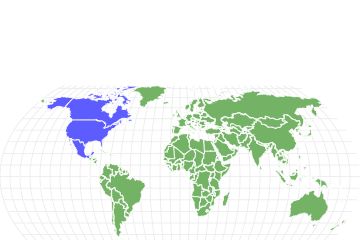Rufous Hummingbird
Selasphorus rufus
The males have a glowing iridescent orange patch on their chests.
Advertisement
Rufous Hummingbird Scientific Classification
- Kingdom
- Animalia
- Phylum
- Chordata
- Class
- Aves
- Order
- Apodiformes
- Family
- Trochilidae
- Genus
- Selasphorus
- Scientific Name
- Selasphorus rufus
Read our Complete Guide to Classification of Animals.
Rufous Hummingbird Conservation Status
Rufous Hummingbird Facts
- Prey
- Some insects
- Group Behavior
- Solitary/Pairs
- Fun Fact
- The males have a glowing iridescent orange patch on their chests.
- Biggest Threat
- Loss of habitat and food due to climate change.
- Most Distinctive Feature
- Reddish-orange coloring.
- Incubation Period
- 2 weeks
- Age Of Independence
- 3 weeks
- Predators
- Snakes, larger birds and animals
- Diet
- Omnivore
- Favorite Food
- Red flowers
- Special Features
- The males have an iridescent orange patch on their chests.
- Number Of Species
- 1
- Location
- North America
- Nesting Location
- In trees and shrubs
- Migratory
- 1
Rufous Hummingbird Physical Characteristics
- Color
- Red
- White
- Green
- Orange
- Multi-colored
- Skin Type
- Feathers
- Length
- 2-3 inches
- Age of Weaning
- Less than 1 month
- Venomous
- No
- Aggression
- Medium
View all of the Rufous Hummingbird images!
This hummingbird has brilliant coloring and can travel from Alaska to Mexico in one migration.
As one of nine species of hummingbirds in its genus, the Rufous hummingbird is named for the reddish-orange coloring that most males have on their heads and chests. They favor red-colored flowers but also eat insects. Learn more about these fascinating birds.
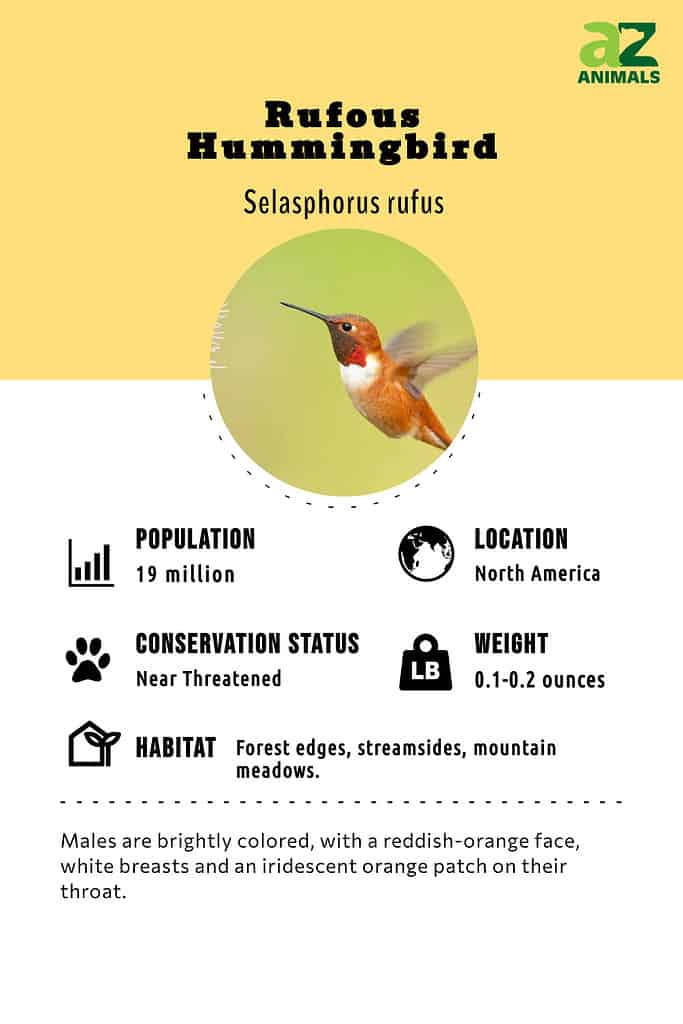
Rufous Hummingbird Amazing Facts
- The Rufous hummingbird was discovered and named in 1788. It is now the type species for its genus, Selasphorus.
- These hummingbirds travel from the northern U.S. and Canada to Mexico when they migrate.
- Females can reuse and refurbish old nests with grass, moss, and soft plants to create a cozy place for eggs.
- Rufous hummingbirds beat their wings to hover in place while they eat nectar from flowers with their long tongues.
- Snakes like to eat Rufous hummingbirds when they can catch one.
Where To Find The Rufous Hummingbird
The Rufous hummingbird is native to North America, from Alaska to Mexico. They breed in Alaska and the Western parts of Canada and the United States during the spring and summer. They take advantage of native wildflowers in these regions as a reliable source of food. For the winter, they travel almost 4,000 miles to migrate to parts of Mexico. They need a warm climate to survive and cannot overwinter in the northern parts of the continent.
Scientific Name
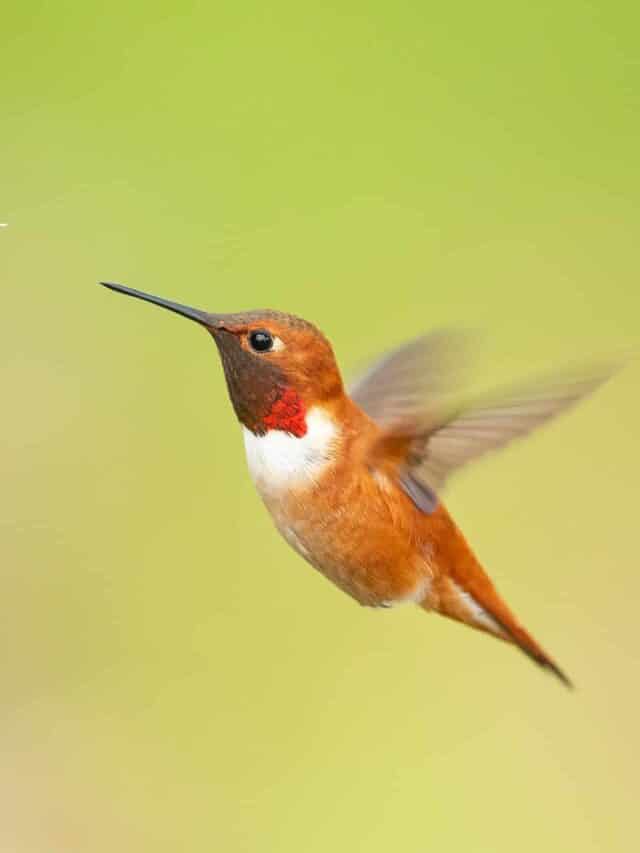
Rufous Hummingbirds are one of nine species in the genus
Selasphorus.
©Keneva Photography/Shutterstock.com
This little hummingbird is known by the scientific name Selasphorus rufus. It is one species within the Selasphorus genus. There are nine species within the genus, which was established in 1832. The Rufous hummingbird is the type species. Previously, it was placed in the Trochilus genus along with other hummingbirds when it was discovered and described in 1788.
The Rufous hummingbird is part of the Trochilidae family. It includes all hummingbirds, around 360 species in total. Hummingbirds are recognized by their ability to hover and feed on nectar, although they also eat insects. They were given the name hummingbird due to the humming sound that their fast-beating wings make when they hover.
Hummingbirds belong to the Apodiformes order of birds, which also includes Swifts and Treeswifts. It is one of the most diverse orders of birds and has more than 450 species. They are part of the Aves class, which includes all birds. Birds are characterized by the presence of feathers, toothless beaks, a heart with four chambers, a high metabolism, and a lightweight skeleton. All birds also lay eggs to reproduce. Hummingbirds are part of the Chordata phylum and Animalia kingdom.
History And Evolution
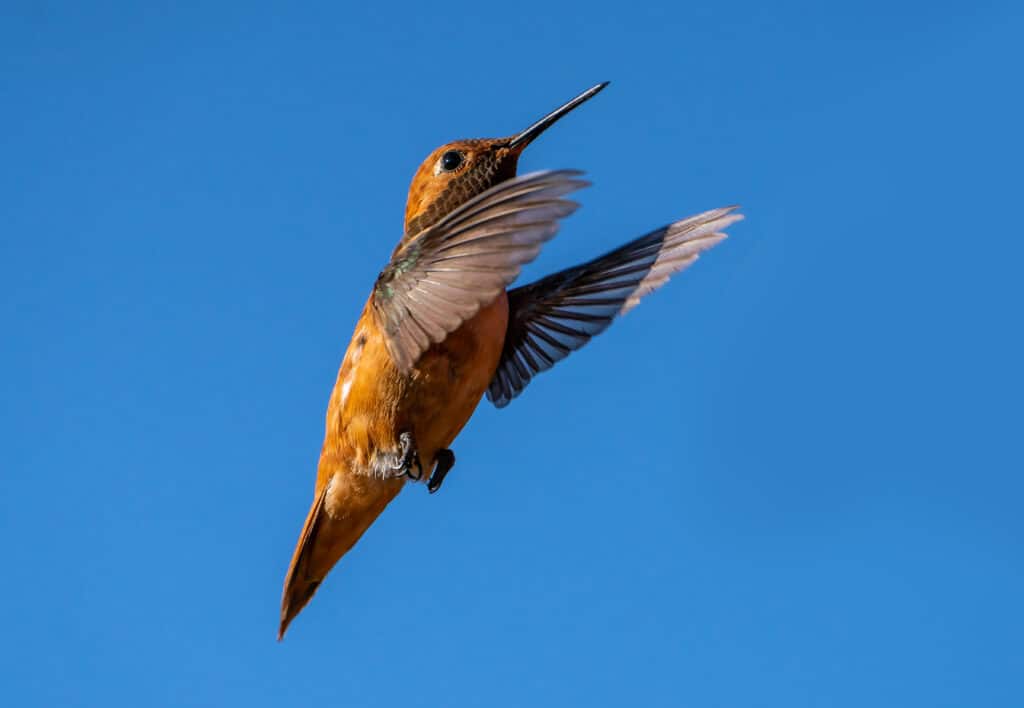
Male Rufous Hummingbirds can have the longest migration of any North American hummingbird and nest as far north as Alaska.
©iStock.com/Darryl Saffer
While the Rufous hummingbirds are native to North America, they are part of a larger species of hummingbirds that began in Europe around 42 million years ago, when they began to diverge from their closest living relatives, the swift. The oldest known fossil is from southeast Germany, around 30 million to 35 million years ago. However, this species became extinct in Europe, it is still unknown how or why, and eventually migrated to North America and South America. The hummingbird of today evolved in the Americas about 22 million years ago.
Types Of
The Rufous hummingbird is in a genus that includes eight other species. This genus, Selasphorus, has the following hummingbirds:
- Allen’s Hummingbird (Selasphorus sasin) – found in coastal California, southern coastal Oregon, and southern central Mexico
- Glow-throated Hummingbird (Selasphorus ardens) – found in western Panama
- Wine-throated Hummingbird (Selasphorus ellioti) – found in El Salvador, Guatemala, Honduras, and Mexico
- Calliope Hummingbird (Selasphorus calliope) – found in California to British Columbia; migrates to Southwest United States and Mexico.
- Bumblebee Hummingbird (Selasphorus heloisa) – found in Mexico
- Broad-tailed Hummingbird (Selasphorus platycercus) – found in western Canada, western United States, Mexico and Guatemala
- Volcano Hummingbird (Selasphorus flammula) – found in Costa Rica and Panama
- Scintillant Hummingbird (Selasphorus scintilla) – found in Costa Rica and Panama
Size, Appearance, And Behavior

Male Rufous Hummingbirds are brightly colored, with a reddish-orange face.
©Keneva Photography/Shutterstock.com
These tiny hummingbirds are around three inches long. They are not the smallest of all hummingbirds but do represent a good example of these interesting animals. The males are brightly colored, with a reddish-orange face. This gave them their name, Rufous, based on this coloring. They have white breasts and an iridescent orange patch on their throat. In fact, the Audubon Society Guide to North American Birds describes it as “glowing like a copper penny.” This helps bird watchers spot Rufous Hummingbirds easier, although this coloring is unique to the males.
Some males also have green coloring on their backs or at the crown of their heads. Females more often have green coloring and are slightly larger than the males. They look similar to the Allen’s hummingbird, which also lives in many of the same places.
Diet
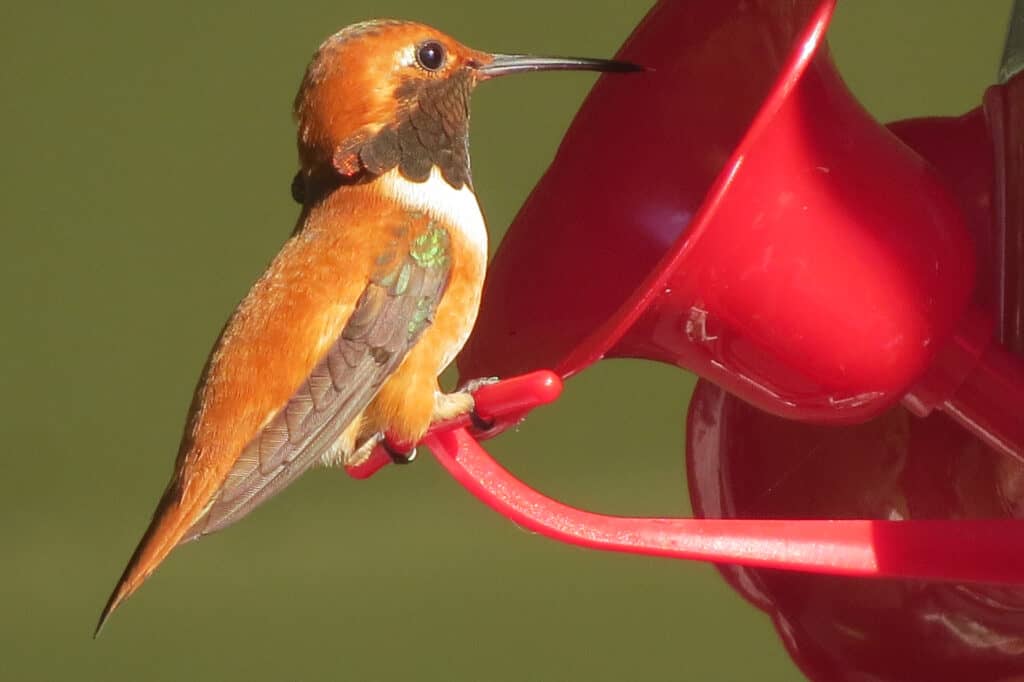
When feeding at hummingbird feeders, Rufous hummingbirds like to perch if they can.
©Rachel Lambert/Shutterstock.com
Like other species of hummingbirds, the Rufous hummingbird eats nectar from flowers. It uses a long proboscis and tongue to access the nectar buried deep in the flower’s structure. It also eats insects that it catches on its wings. They tend to feed on red flowers, including penstemons, red columbines, paintbrush, scarlet sage, and gilia.
When feeding, the Rufous hummingbird hovers in mid-air using its wings. They use downstrokes to generate lift at a greater rate than upstrokes. When feeding on sugar substances at hummingbird feeders, they do perch when given the chance. This helps them conserve energy, although they do not perch for long periods of time.
Predators And Threats
Because they are small, Rufous hummingbirds can be prey for other larger birds and animals. Snakes in particular are quick to make a meal out of an unsuspecting Rufous hummingbird.
Other threats include changes to their habitat and food sources. Pesticides can impact the availability of insects that make up a critical part of their diet. They are not picky when it comes to the type of insects that they eat, although there does need to be a ready supply. Early blooming of their flower food source can also make it hard for them to get enough to eat. They migrate and if the flowers have already bloomed by the time they get to their destination, Rufous Hummingbirds are not able to get the nectar inside.
Reproduction, Babies, And Lifespan
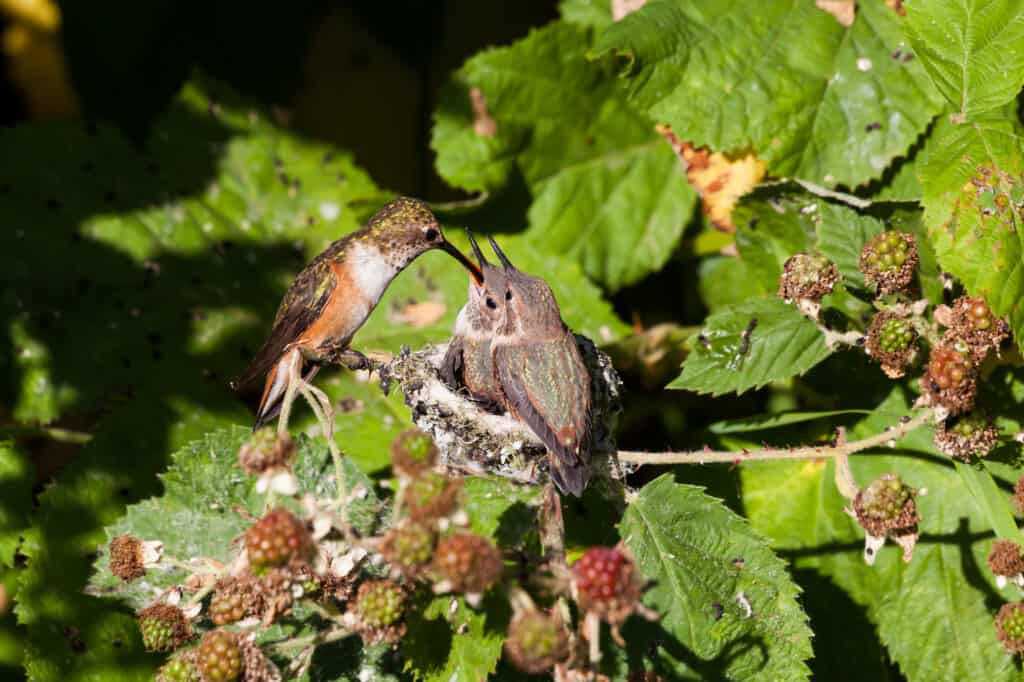
Rufous hummingbird females feed the young hummingbirds, who eventually leave the nest and fly around three weeks old.
©Feng Yu/Shutterstock.com
Like all other birds, the Rufous hummingbird lays eggs. The females build nests in trees and shrubs that are protected and hidden from predators. She uses moss to help the nest blend in better. They can also use old nests and refurbish them with additional grass, moss, and plant matter to make it sturdy and soft. The males will mate with more than one female, who then looks after the eggs until they hatch. This typically takes around two weeks. The females feed the young hummingbirds, who eventually leave the nest and fly around three weeks old.
They typically stay around the Pacific Northwest when breeding, including Oregon, Washington, and Canada. They can travel as far north as Alaska, although they are less common in this area.
Population
Scientists are watching the Rufous Hummingbird population, which has been declining in recent years. While not listed as endangered, the International Union for Conservation of Nature did upgrade it to Near Threatened in 2018 based on population numbers and observations. The Nature Conservancy Canada estimates that its numbers have declined by as much as 60% since data was collected in the mid-1960s.
The change in climate and temperature are thought to be the biggest threats to this hummingbird. As migratory birds, they rely on the seasons to dictate not only their nesting habits but also make their food sources available. If these change, it can have long-term effects on the Rufous Hummingbird population.
Similar Birds To The Rufous Hummingbird
Allen’s Hummingbird: This hummingbird, known by its scientific name Selasphorus sasin, is closely related to the Rufous Hummingbird and has similar coloring. It tends to stay near California, however, and has a more limited geographic range.
Ruby-throated Hummingbird: The Archilochus colubris has a brighter patch of ruby-colored feathers at its throat, which makes it easy to spot. It lives in similar climates to the Rufous Hummingbird but also goes to the Eastern United States to breed.
Related Animals
View all 114 animals that start with RRufous Hummingbird FAQs (Frequently Asked Questions)
How can you tell if a hummingbird is a Rufous Hummingbird?
The best visual indicator is the iridescent patch that the males have on their chests, which is reddish-orange in color. They also have recognizable reddish-orange coloring on their backs and heads, although some males and most females can also have green heads.
Why are Rufous Hummingbirds important?
Like any other hummingbird or animal that feeds on nectar, Rufous Hummingbirds play an important role in plant pollination. As they eat, pollen collects on their wings and body. This pollen is then carried to other plants, resulting in pollination and new growth.
Why are Rufous Hummingbirds aggressive?
All hummingbirds can get aggressive with each other over food and resources. Rufous Hummingbirds will fight with other birds and animals over access to nectar as well as space at feeders.
Thank you for reading! Have some feedback for us? Contact the AZ Animals editorial team.
Sources
- Audobon Guide to North American Birds, Available here: https://www.audubon.org/field-guide/bird/rufous-hummingbird
- Nature Conservancy Canada, Available here: https://www.natureconservancy.ca/en/what-we-do/resource-centre/featured-species/birds/rufous-hummingbird.html
- The Cornell Lab, All About Birds, Available here: https://www.allaboutbirds.org/guide/Rufous_Hummingbird/overview#

